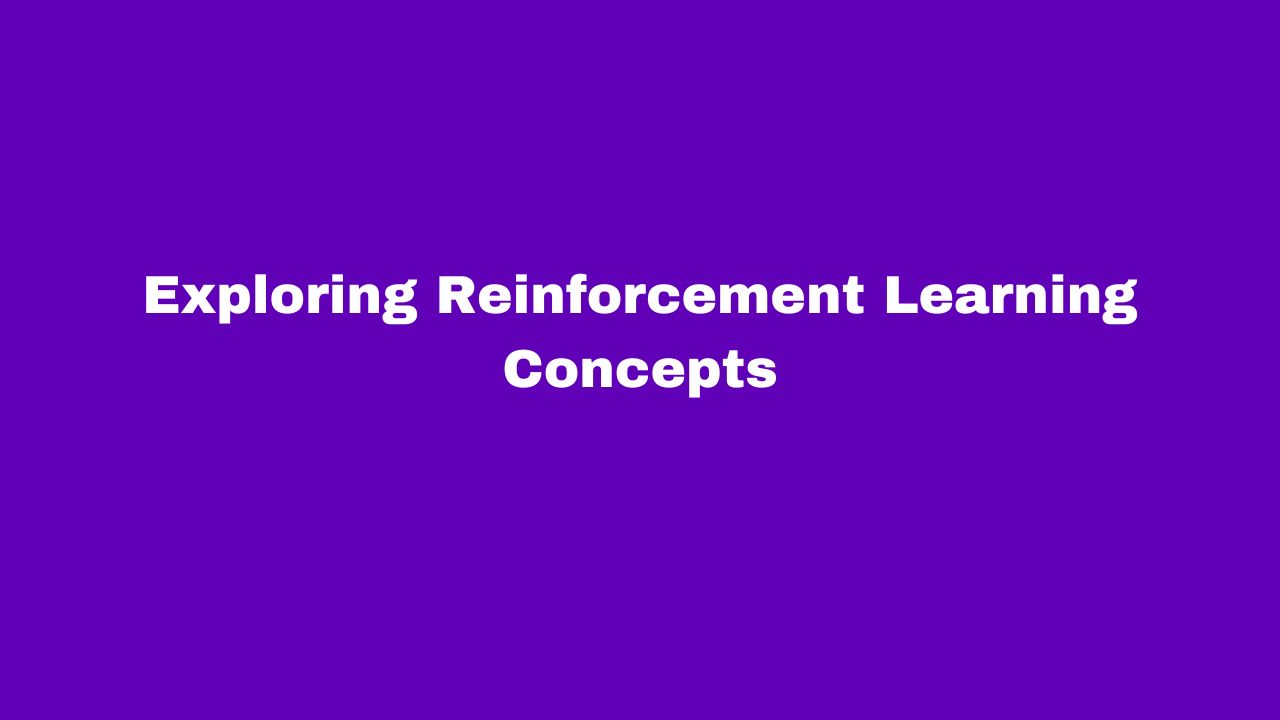
Exploring Reinforcement Learning Concepts#
Reinforcement Learning (RL) is a rich and complex field with many important concepts. Here are some high level concepts which you need to understand, and explore this field.
Key Concepts of Reinforcement Learning (RL)#
1. Markov Decision Processes (MDPs)#
- Definition: The mathematical framework for RL, consisting of states, actions, transitions, and rewards.
- Key Components:
- State (S): The current situation of the agent.
- Action (A): Choices available to the agent.
- Transition Function (P): Probability of moving to a new state given an action.
- Reward Function (R): Immediate feedback for taking an action in a state.
- Discount Factor (γ): Determines the importance of future rewards.
- Extensions:
- Partially Observable MDPs (POMDPs): When the agent cannot fully observe the state.
- Continuous MDPs: For continuous state and action spaces.
2. Policies#
- Definition: A strategy that the agent uses to decide actions based on states.
- Types:
- Deterministic Policy: Maps states to specific actions.
- Stochastic Policy: Maps states to probability distributions over actions.
- Optimal Policy: The policy that maximizes cumulative rewards.
3. Value Functions#
- State-Value Function (V): Expected cumulative reward from a state under a policy.
- Action-Value Function (Q): Expected cumulative reward for taking an action in a state and following a policy.
- Bellman Equation: Recursive relationship used to compute value functions.
4. Exploration vs. Exploitation#
- Exploration: Trying new actions to discover their effects.
- Exploitation: Choosing known actions that yield high rewards.
- Balancing Mechanisms:
- ε-Greedy: Randomly explores with probability ε.
- Softmax: Selects actions based on a probability distribution.
- Upper Confidence Bound (UCB): Balances exploration and exploitation based on uncertainty.
5. Algorithms#
- Model-Based vs. Model-Free:
- Model-Based: Learns a model of the environment (transition and reward functions).
- Model-Free: Learns directly from interactions without modeling the environment.
- Key Algorithms:
- Q-Learning: Off-policy algorithm for learning action-value functions.
- SARSA: On-policy algorithm for learning action-value functions.
- Deep Q-Networks (DQN): Combines Q-learning with deep neural networks.
- Policy Gradient Methods: Directly optimize the policy (e.g., REINFORCE, PPO, TRPO).
- Actor-Critic Methods: Combines value-based and policy-based approaches.
6. Function Approximation#
- Purpose: Handles large or continuous state/action spaces.
- Methods:
- Linear Approximation: Uses linear combinations of features.
- Neural Networks: Deep learning for complex function approximation.
- Challenges:
- Overfitting, instability, and divergence.
7. Temporal Difference (TD) Learning#
- Definition: Combines Monte Carlo methods and dynamic programming for online learning.
- Key Concepts:
- TD Error: Difference between estimated and actual returns.
- Bootstrapping: Updating estimates based on other estimates.
8. Eligibility Traces#
- Purpose: Improves efficiency of TD learning by considering recent states and actions.
- Example: TD(λ), where λ controls the trace decay.
9. Multi-Agent RL (MARL)#
- Definition: Extends RL to environments with multiple agents.
- Challenges:
- Non-stationarity (other agents are also learning).
- Coordination and competition.
- Approaches:
- Cooperative, Competitive, and Mixed settings.
10. Transfer Learning in RL#
- Definition: Applying knowledge from one task to another.
- Methods:
- Domain Adaptation: Adjusting to new environments.
- Skill Transfer: Reusing learned policies or value functions.
11. Safe and Ethical RL#
- Safe Exploration: Avoiding harmful actions during learning.
- Ethical Constraints: Incorporating human values into reward design.
12. Hierarchical RL (HRL)#
- Definition: Breaks tasks into sub-tasks or sub-goals.
- Methods:
- Options Framework: Temporal abstractions for actions.
- MAXQ: Hierarchical decomposition of value functions.
13. Imitation Learning#
- Definition: Learning from expert demonstrations.
- Methods:
- Behavior Cloning: Supervised learning to mimic expert actions.
- Inverse RL: Inferring the reward function from demonstrations.
14. Meta-Learning in RL#
- Definition: Learning to learn, or adapting quickly to new tasks.
- Methods:
- Model-Agnostic Meta-Learning (MAML): Adapts to new tasks with few samples.
- RL²: Treats the RL algorithm itself as a learning problem.
15. Exploration Strategies#
- Intrinsic Motivation: Encourages exploration through curiosity or novelty.
- Count-Based Exploration: Rewards visiting rare states.
- Random Network Distillation (RND): Uses prediction errors to drive exploration.
16. Challenges in RL#
- Sample Efficiency: Learning with limited interactions.
- Credit Assignment: Determining which actions led to rewards.
- Scalability: Handling high-dimensional state/action spaces.
- Stability: Avoiding divergence during training.
17. Applications of RL#
- Games: AlphaGo, Dota 2, Chess.
- Robotics: Manipulation, locomotion, autonomous driving.
- Healthcare: Personalized treatment, drug discovery.
- Finance: Portfolio optimization, trading strategies.
- Recommendation Systems: Personalized content delivery.
18. Tools and Frameworks#
- Libraries:
- OpenAI Gym: Standardized environments for RL.
- Stable-Baselines3: Implementations of RL algorithms.
- Ray RLlib: Scalable RL for distributed computing.
- Simulators:
- MuJoCo, PyBullet, Unity ML-Agents.
19. Theoretical Foundations#
- Convergence Guarantees: Conditions under which RL algorithms converge.
- Regret Minimization: Balancing exploration and exploitation over time.
- Policy Improvement Theorems: Guarantees for improving policies iteratively.
20. Advanced Topics#
- Off-Policy Learning: Learning from data generated by a different policy.
- Offline RL: Learning from pre-collected datasets without interaction.
- Multi-Task RL: Learning multiple tasks simultaneously.
- Meta-RL: Learning RL algorithms themselves.
What are differening rewardng systems in RL?#
In reinforcement learning (RL), reward systems are pivotal in guiding agents to learn optimal behaviors. Here’s an organized overview of different reward systems, their characteristics, and applications:
1. Sparse vs. Dense Rewards#
- Sparse Rewards: Given only upon significant milestones (e.g., winning a game). Challenges include slower learning due to infrequent feedback. Example: Chess AI receiving a reward only at checkmate.
- Dense Rewards: Frequent feedback for incremental progress (e.g., points for moving closer to a goal). Facilitates faster learning but risks reward hacking. Example: Robot navigation with step-by-step rewards.
2. Reward Shaping#
- Modifies the environment’s reward function to include intermediate rewards, easing learning. Requires caution to avoid suboptimal policies. Example: Adding rewards for collecting items in a game before reaching the final goal.
3. Intrinsic Motivation#
- Encourages exploration through internal drives:
- Curiosity-Driven: Rewards agents for novel states or prediction errors (e.g., exploring unseen areas in Montezuma’s Revenge).
- Count-Based: Penalizes frequently visited states to promote diversity (e.g., exploration bonuses in grid worlds).
4. Inverse Reinforcement Learning (IRL)#
- Infers reward functions from expert demonstrations. Used when rewards are hard to specify (e.g., autonomous driving mimicking human behavior).
5. Multi-Objective Rewards#
- Balances multiple goals using weighted sums or Pareto optimization. Example: Self-driving car optimizing safety and speed.
6. Hierarchical Rewards#
- Decomposes tasks into subgoals with layered rewards. Hierarchical RL (HRL) uses high-level policies to set subgoals (e.g., robot assembling parts stepwise).
7. Risk-Sensitive Rewards#
- Incorporates risk metrics (e.g., variance) to avoid high-risk actions. Critical in finance or healthcare applications.
8. Transfer Learning with Rewards#
- Transfers knowledge from pre-trained tasks to new domains. Example: Using simulation rewards to train real-world robots.
9. Curriculum Learning#
- Gradually increases task difficulty, adjusting rewards to match. Early stages provide guided rewards, later stages reduce them.
10. Potential-Based Reward Shaping#
- Shapes rewards using state potential differences, preserving original optimal policies. Avoids unintended behaviors from arbitrary shaping.
11. Ethical/Safe Rewards#
- Embeds human values to prevent harm. Example: A robot avoiding actions that risk human safety.
12. Dynamic Reward Functions#
- Adapts rewards over time to prevent stagnation. Example: Increasing exploration bonuses as the agent plateaus.
13. Imitation Learning#
- Combines expert demonstrations with RL. Methods include:
- Behavior Cloning: Directly mimics expert actions.
- Apprenticeship Learning: Infers rewards from demonstrations (akin to IRL).
Additional Considerations:#
- Cooperative vs. Competitive Rewards: In multi-agent RL, rewards can be team-based (cooperative) or adversarial (competitive).
- Human-in-the-Loop Feedback: Interactive RL where humans provide real-time feedback (e.g., thumbs-up/down for actions).
- Discount Factors: While not a reward system, discount rates (γ) influence long-term vs. short-term reward prioritization.
Challenges:#
- Reward Hacking: Agents exploiting loopholes (e.g., repetitive point-scoring in games).
- Specification Gaming: Unintended behaviors due to poorly designed rewards.
Examples in Practice:#
- AlphaGo: Sparse win/loss rewards combined with imitation learning from human games.
- Robotics: Dense rewards for precise movements, balanced with risk penalties.
Each system has trade-offs; selecting one depends on task complexity, available data, and desired agent behavior. Combining methods (e.g., intrinsic + extrinsic rewards) often yields robust solutions.


Comments: